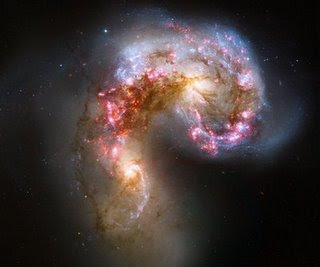KOSMOLOGI
The Milky Way galaxy is threatened in Hit Giant Cloud,
Clots containing a giant cloud of hydrogen gas in the middle of a very
large volume disc bolted approaching the Milky Way, where our Solar
System belongs.
Devastating collision is expected to occur between 20-40 million years
would generate a huge fireworks spectacular at the same time destroy all
forms of life. The object is named Awan Smith, named GailSmith, a US
astronomer who first detected in 1963 while researching at the
University of Leiden, Belanda.Sejak discovered, astronomers are still
debating whether the clouds are really approaching the Milky Way or away
from it. Data records that have so far been limited and it is not clear
whether the object is a part of the Milky Way or the fog is still
moving toward him.
So far, the researchers detected only gas and no single star in it. The
only way melihtanya round by radio telescopes because of the cold gas
does not emit light, but reflects radio waves.
When viewed from Earth, the clouds width comparable to 30 times the
width of the Moon. From the head to the tip of its tail is enough to
envelop the constellation Orion. The new observations using radio
telescopes in control most of the world, the Green Bank Telescope (GBT)
in West Virginia, US, indicates that the object is moving toward the
Milky Way galaxy. In fact, as reported by a combined team of astronomers
from the US National Radio Astronomy Observatory (NRAO) and the
University of Wisconsin Whitewater in the meeting of the American
Astronomical Society to-211 in Austin, Texas recently, the driving force
has touched the mist of the Milky Way. "If a collision occurs, it will
trigger the birth of new star formation. There will be many giant stars
are formed, short-lived, and exploded as a supernova that emit blinding
light," said the team leader, DR. Felix Lockman, from the NRAO.
Because, Cloud Smith brings enormous energy in the form of hydrogen gas
enough to form millions of sun-sized star. Smith is a gas cloud clumps
measuring 11,000 light-years long and 2,500 light-years wide. The object
is currently located 40,000 light-years from Earth and 8,000 light
years from the disk Bimasakti.Objek deserve the mist monsters in this
cosmos space moving at a speed of 240 kilometers per second and is
expected to hit the disc of the Milky Way galaxy with a slope of 45
degrees. Collisions will occur at the edge of the disk of the Milky Way
almost the same distance to the center of our solar system to the
distance to the center of the galaxy. However, the position is far from
our solar system, is expected within 90 degrees towards the center of
the dish. "We do not know where it came from, let alone its orbit
confusing, but we say that she begins to interact with the outer parts
of the Milky Way," said Lockman.


Comments
Post a Comment